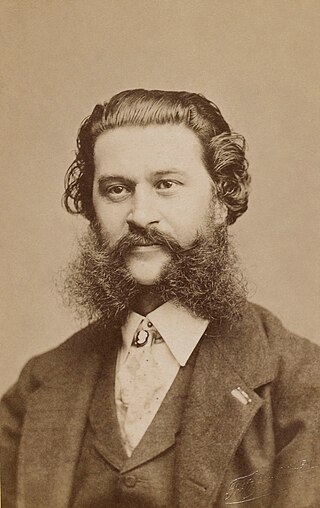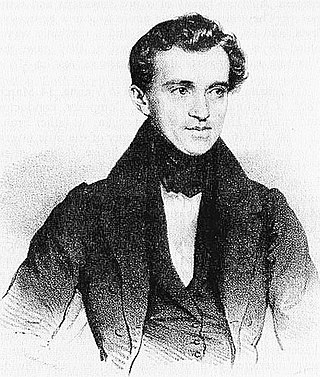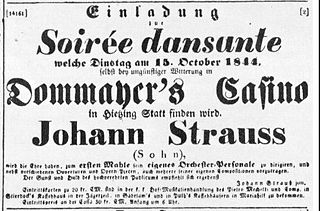Related Research Articles

Johann Baptist Strauss II, also known as Johann Strauss Jr., the Younger or the Son, was an Austrian composer of light music, particularly dance music and operettas as well as a violinist. He composed over 500 waltzes, polkas, quadrilles, and other types of dance music, as well as several operettas and a ballet. In his lifetime, he was known as "The Waltz King", and was largely responsible for the popularity of the waltz in Vienna during the 19th century. Some of Johann Strauss's most famous works include "The Blue Danube", "Kaiser-Walzer", "Tales from the Vienna Woods", "Frühlingsstimmen", and the "Tritsch-Tratsch-Polka". Among his operettas, Die Fledermaus and Der Zigeunerbaron are the best known.

Johann Baptist Strauss I, also known as Johann Strauss Sr., the Elder or the Father, was an Austrian composer of the Romantic Period. He was famous for his light music, namely waltzes, polkas, and galops, which he popularized alongside Joseph Lanner, thereby setting the foundations for his sons—Johann, Josef and Eduard—to carry on his musical dynasty. He is best known for his composition of the Radetzky March.

Josef Strauss was an Austrian composer.

Wein, Weib und Gesang, Op. 333, is a Viennese waltz by Johann Strauss II. It is a choral waltz in its original form, although it is seldom heard in this version today. It was commissioned for the Vienna Men's Choral Association's so-called Fools' Evening on 2 February 1869 with a dedication to the Association's honorary chorus-master Johann Herbeck. Its fanciful title was drawn from an old adage: "Who loves not wine, women and song remains a fool his whole life long."
Accelerationen (Accelerations), op. 234, is a waltz composed by Johann Strauss II in 1860 for the Engineering Students' Ball at the Sofienbad-Saal in Vienna. It is one of his best-known waltzes, famous especially for its rapidly accelerating opening waltz theme.
Mephistos Höllenrufe, Op. 101, is a waltz composed by Johann Strauss II in 1851. It was first performed at the Vienna Volksgarten as part of a festival preceding Strauss' departure for a tour of Germany. The title of the composition is a quotation from the Bible: "And the devil [Mephistopheles] [...] was cast into the lake of fire and brimstone, where the beast and the false prophet are, and shall be tormented day and night for ever and ever". A reporter for the Wiener Allgemeine Theaterzeitung commented on Strauss' waltz that it "received such a favourable reception, on account of its effective and original melodies and brilliant instrumentation, that it had to be repeated three times". Especially colourful, and keeping with the work's ominous title, is the second waltz theme: its cheerful, ascending tune is suddenly interrupted, and then answered by a sinister chromatic descending passage. Some of the waltz themes of the work are found in close proximity to one another in the earliest of Strauss' "sketchbooks", and were probably written in the first half of 1851.

Bei uns z'Haus, Op. 361, is a Viennese waltz composed by Johann Strauss II for the 1873 Vienna World's Fair. It was first performed in August 1873 at the 'Neue Welt' establishment in Hietzing, Vienna.
Klangfiguren, Op. 251, is a waltz composed by Johann Strauss II. It was his dedication composition for the ball of the technical students of the Vienna University, which was held in Vienna's Sofienbad-Saal in February 1861.
O schöner Mai!, Op. 375, is a waltz composed by Johann Strauss II. It features melodies from Strauss's fifth operetta, Prinz Methusalem. The waltz was first performed in January 1877, with Eduard Strauss conducting. The principal waltz theme of this work is a quote from the Act 3 duet for Pulcinella and Methusalem, while the remaining melodies are taken from Acts 1 and 2, including the Act 1 Chorus and Ensemble, "O schöner Mai!".
Frohsinns-Spenden, opus 73, is a waltz composed by Johann Strauss II. The composition premiered in January 1850 in the Sofienbad-Saal, at a charity ball.
Phänomene (Phenomena), opus 193, is a waltz composed by Johann Strauss II. The waltz was dedicated to the technical students of the Vienna University, and was first performed on the occasion of their ball in the Sofienbad-Saal in February 1857. This composition belongs to the series of Strauss waltzes which reflect the composer's fascination for avant-garde orchestrations and harmonic styles of Hector Berlioz and Richard Wagner.

Gunstwerber, Op. 4, is a waltz by Johann Strauss II.

Sinngedichte, Op. 1, is a waltz composed by Johann Strauss II in 1844 for his debut as a composer at Dommayer's Casino in Vienna. The waltz was played along with several other compositions that Strauss had written for the occasion, such as the waltz Gunstwerber and the polka Herzenslust. The waltz was an unprecedented success when first performed, and had to be repeated a record nineteen times.
Carnevalsbilder, opus 357, is a waltz composed by Johann Strauss II. The waltz is based on melodies from Strauss' operetta Der Karneval in Rom. Strauss conducted its first performance in Vienna on July 9, 1873. Oscar Straus later arranged the second waltz theme of Carnevalsbilder for his operetta Drei Walzer as the soprano aria Ich liebe das Leben.
Idyllen (Idylls), Op. 95, is a waltz composed by Johann Strauss II in 1851. It was composed for a "Grand Summer Festival Soiree" in the Vienna Volksgarten, with the composer conducting the Strauss Orchestra in its first performance. The fifth waltz melody of the work incorporates themes from the popular song O Madchen mein unter'm Hollerstock. The Theater Zeitung commented on the Strauss waltz that "it is most original and displays a multitude of piquant dance rhythms which are instrumented with much spirit and, amidst tumultuous applause from the select and numerous public, had to be played da capo."
Aus den Bergen, opus 292, is the name of a waltz composed by Johann Strauss II. The work was first performed in Pavlovsk on October 2, 1864, under the title In den Bergen. The composition was dedicated to the music critic Eduard Hanslick. Critics commented on Strauss' waltz that "after a long time a new waltz from Johann Strauss has appeared, which is distinguished by noble and graceful character, and further distinguished by extraordinarily masterful instrumentation." The first Viennese performance of the waltz was in the Volksgarten as part of a benefit concert commemorating Strauss' twentieth anniversary of his debut as a composer.
Promotionen (Graduations), Op. 221, is the name of a waltz composed by Johann Strauss II. It was dedicated to the law students at the Vienna University, and was first performed under the title of Die Präparanden, a term referring to students who are preparing for their final examinations. The waltz was not very successful when first performed in the Sofienbad-Saal on February 8 1859: the Fremden-Blatt, although praising the execution of the waltz, said that it "lacked the rhythm and melody of older Strauss compositions." However, a reviewer for the Wiener Allgemeine Theaterzeitung was less critical of the composition, commenting that "in particular the first, third and fifth [waltz sections] are rich in fresh and attractive melodies [...] through this composition Strauss has lately demonstrated that he still has at his disposal a profusion of piquant and original melodies."
Rhadamantus-Klänge, Op. 94, is a waltz composed by Johann Strauss II. It was written for the 1851 Vienna Carnival. The title of the work was named after Rhadamanthus, one of the judges of the underworld in Greek mythology. Eduard Strauss, the composer's youngest brother, included the waltz's opening number in his potpourri Bluthenkranz Johann Strauss'scher Walzer, opus 292.
Lava-Ströme, opus 74, is the name of a waltz composed by Johann Strauss II. It was written to commemorate the volcanic activity within Vesuvius in 1850. The waltz was first performed at a benefit ball going under the title of a "Ball in Vesuvius" at the Sofienbad-Saal in Vienna on January 29, 1850.
Abschied von St. Petersburg, opus 210, is the name of a waltz composed by Johann Strauss II. The work was first performed at a benefit concert in Pavlovsk on September 5, 1858, as part of a tour of Russia that Strauss was conducting. In keeping with the vogue then current in Russia for the French language, the work was entitled as Mes adieux à St. Pétersbourg. Less than a week after his return to his home city of Vienna, Strauss conducted the first Viennese performance of the work at the Vienna Volksgarten.
References
- ↑ "STRAUSS II, J.: Edition - Vol. 4 CD". NaxosDirect. Archived from the original on 2008-06-09. Retrieved 2008-10-09.